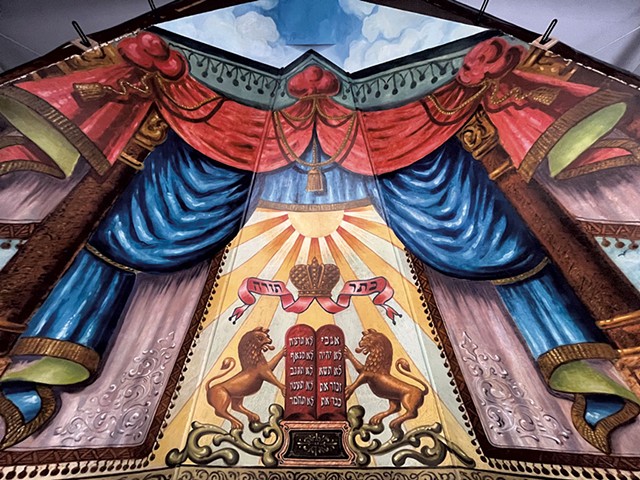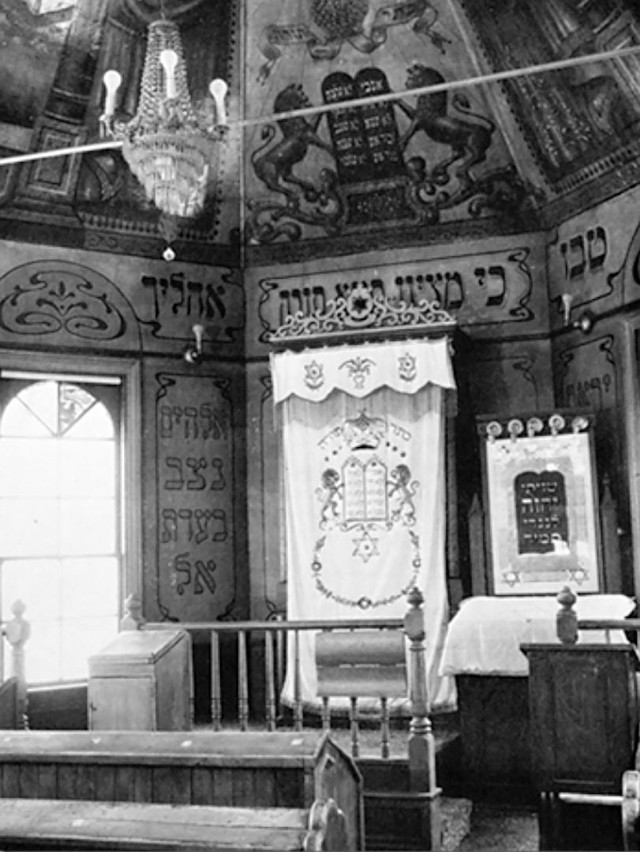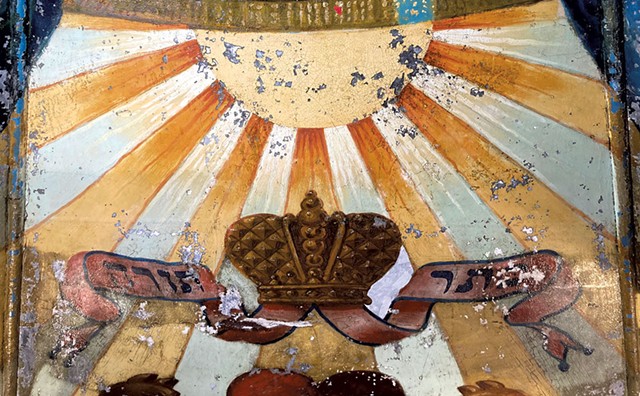
- Courtesy Of The Lost Mural Project
- Restored mural
In 1910, a 24-year-old Lithuanian immigrant and professional sign painter named Ben Zion Black created a vibrant mural in the sanctuary of a synagogue on Hyde Street in Burlington's Old North End. For his work, the congregation paid him $200. The 22-foot-wide, 10-foot-high triptych — rendered in an Eastern European folk-art style — features the Ten Commandments in its center, bathed in the sun's rays and flanked by golden lions. Billowy blue-and-red curtains and stately pillars fill the side panels.
Little did Black know that his artwork, which is now displayed in the entryway of Ohavi Zedek Synagogue on North Prospect Street, would one day become an international treasure — or that members of Burlington's Jewish community would spend years raising $1 million and assembling a large team to protect, move, clean and restore it.
This month, after years of painstaking work, the restoration of Black's artwork — which has become known as the "Lost Mural" — was finally finished. A celebration on June 28 will mark the occasion. It will honor former Vermont governor and Jewish immigrant Madeleine Kunin, who helped fundraise for the mural, and feature Nisht Geferlach Klezmer Band, Vermont's only klezmer group.
"I think a lot of people are astonished by the communal effort that went into this project," said Aaron Goldberg, retired Ohavi Zedek archivist and cofounder of the Lost Mural Project. The restored work tells a multifaceted story that encompasses culture, art, history and religion, he said.
Also notable is the mural's rarity. In Lithuania, about 500 synagogues once had hand-painted walls, Goldberg said. All but one were destroyed during the Holocaust.
Josh Perelman, chief curator and director of exhibitions and interpretation at the Weitzman National Museum of American Jewish History, called the work "one of a kind" and said nothing like it exists in American synagogues, either.
The history of Burlington's Jewish community underscores the significance of the "Lost Mural." In the late 1880s, a group of about 100 Jewish settlers, most from a small Lithuanian village named Čekiškė, settled in Burlington's Old North End. The community soon grew into a bustling neighborhood with a kosher baker, kosher butcher, grocery store, feed store and three Orthodox synagogues. One of them — Chai Adam Synagogue, built in 1889 — was the original site of Black's mural.

- Courtesy Of The Lost Mural Project
- The only known photo of the mural at Chai Adam Synagogue
In 1939, Chai Adam closed, and the Wheel family purchased the building. They eventually turned it into a carpet store and warehouse but kept Black's painting. In 1986, the property changed hands again, and the new owners, the Francis family, planned to convert it into an apartment building.
But before they did, Goldberg, a Burlington native who descended from Lithuanian immigrants, stepped in. He helped persuade the owners to preserve the mural by hiding it behind a newly built wall. First, though, photographers captured archival images with financial help from Black's daughters. Those 1986 photographs would provide critical reference material for the restoration of the mural more than three decades later.
Before it could be restored, however, the mural had to be moved. In 2012, Goldberg and childhood friend and former Trinity College of Vermont history professor Jeff Potash — by then cofounders of the Lost Mural Project — reached an agreement with new owner Steven Offenhartz to open up the wall that covered the mural. Because of its location — in an apartment that was heated all winter — the work had sustained extensive damage, with paint hanging off its plaster base "like cornflakes," said Richard Kerschner, conservator emeritus at Shelburne Museum. Kerschner, who was director of preservation and conservation at the museum for more than three decades, coordinated the mural conservation efforts.
First, the mural was stabilized; conservators painstakingly glued paint back on, chip by chip, and gave it an initial cleaning. Then, in May 2015, a team of contractors extracted it from the Hyde Street building and transported it several blocks to the Ohavi Zedek entryway. Encased in steel, it weighed about 7,500 pounds.
Nearly six years passed as money was raised to complete the restoration.
From April to August of 2021, conservators Constance Silver and Jennifer Baker cleaned the mural, which hangs from suspension beams in the synagogue's ceiling. They used a gel solvent and cotton swabs to remove darkened varnish, dirt and grime from the painting's surface. Each color in the mural required that the gel be applied for a specific amount of time, Kerschner explained. The conservators sent paint samples to specialists in Maine and New York, who analyzed the layers to make sure none of the original paint was being stripped away.
The cleaning revealed shadows and depth and a new palette of rich colors. The mural was vibrant by design, Kerschner said. Because it was originally on the ceiling of a building with no electric lights, it had to be bright to make an impact.

- Courtesy Of The Lost Mural Project
- Mural detail after cleaning but before restoration
The next phase of restoration began in January of this year and was completed earlier this month. A team of conservators from Williamstown Art Conservation Center in Massachusetts came to Burlington for several days at a time to do the work. First, they used a white spackling compound to fill in the areas where the paint had been chipped away. Then they painted the compound, layering different colors and tones to get the right match. No paint was applied on top of the original paint, though conservators used a tinted varnish over the new and existing paint to make sure the colors appear well blended.
Both the cleaning and restoration were made easier by the pandemic, Goldberg said. Congregants didn't come to in-person services at the synagogue for about two years, which gave conservators uninterrupted time and space to do their work.
The cost of the project — including moving, cleaning and restoring the mural — totaled just over $1 million, Goldberg said. One-third of funding came from individual donations, another third came from local businesses and the final third came from organizations, including the Vermont Arts Council, the Preservation Trust of Vermont, Vermont Humanities, the Vermont Historical Society, the Vermont Division for Historic Preservation and the Vermont Community Foundation. Local contractors and businesses also provided labor and supplies for free or at a discounted rate.
Now that the restoration is complete, the next phase is educating the public by sharing the mural as widely as possible, Goldberg said. Tours will begin this summer. When visitors come to see the work in the synagogue's entryway — which is controlled for temperature, humidity and light in order to protect the mural — they'll also eventually be able to view an exhibit that documents the restoration project with photos, time-lapse video and text. Goldberg also hopes to showcase artworks from different immigrant cultures to highlight their commonalities and to start a lecture series focused on the immigrant experience.
A mobile exhibit that can travel to schools, libraries and town halls will allow those who can't make it to Burlington to learn about the project, which Goldberg and Potash have documented on the project website.
"So many things could have gone wrong with the mural, but it survived through fate and circumstance," Goldberg said. "It's not just a surviving remnant. It's a surviving piece with an astonishing history."
Correction, June 23, 2022: An earlier version of this story misspelled the name of the Lithuanian village Čekiškė online.
Correction, June 27, 2022: An earlier version of this story misstated when the Offenhartz family bought the former synagogue on Hyde Street. They purchased it in 2012. The story also omitted the Vermont Division for Historic Preservation and the Vermont Community Foundation from among Lost Mural Project supporters.










Comments
Comments are closed.
From 2014-2020, Seven Days allowed readers to comment on all stories posted on our website. While we've appreciated the suggestions and insights, right now Seven Days is prioritizing our core mission — producing high-quality, responsible local journalism — over moderating online debates between readers.
To criticize, correct or praise our reporting, please send us a letter to the editor or send us a tip. We’ll check it out and report the results.
Online comments may return when we have better tech tools for managing them. Thanks for reading.